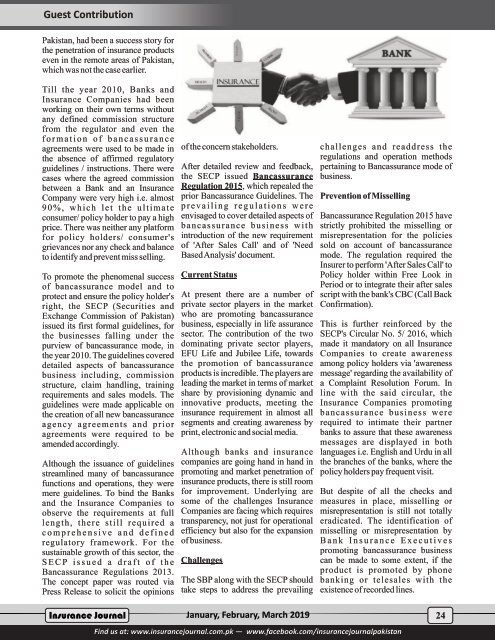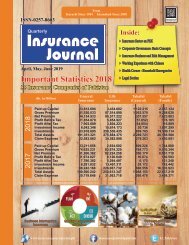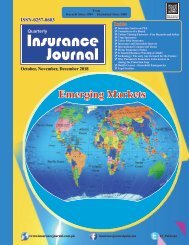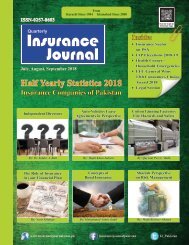Insurance Journal (1st Quarter 2019)
Create successful ePaper yourself
Turn your PDF publications into a flip-book with our unique Google optimized e-Paper software.
Guest Contribution<br />
Pakistan, had been a success story for<br />
the penetration of insurance products<br />
even in the remote areas of Pakistan,<br />
which was not the case earlier.<br />
Till the year 2010, Banks and<br />
<strong>Insurance</strong> Companies had been<br />
working on their own terms without<br />
any defined commission structure<br />
from the regulator and even the<br />
f o r m a t i o n o f b a n c a s s u r a n c e<br />
agreements were used to be made in<br />
the absence of affirmed regulatory<br />
guidelines / instructions. There were<br />
cases where the agreed commission<br />
between a Bank and an <strong>Insurance</strong><br />
Company were very high i.e. almost<br />
90%, which let the ultimate<br />
consumer/ policy holder to pay a high<br />
price. There was neither any platform<br />
for policy holders/ consumer's<br />
grievances nor any check and balance<br />
to identify and prevent miss selling.<br />
To promote the phenomenal success<br />
of bancassurance model and to<br />
protect and ensure the policy holder's<br />
right, the SECP (Securities and<br />
Exchange Commission of Pakistan)<br />
issued its first formal guidelines, for<br />
the businesses falling under the<br />
purview of bancassurance mode, in<br />
the year 2010. The guidelines covered<br />
detailed aspects of bancassurance<br />
business including, commission<br />
structure, claim handling, training<br />
requirements and sales models. The<br />
guidelines were made applicable on<br />
the creation of all new bancassurance<br />
agency agreements and prior<br />
agreements were required to be<br />
amended accordingly.<br />
Although the issuance of guidelines<br />
streamlined many of bancassurance<br />
functions and operations, they were<br />
mere guidelines. To bind the Banks<br />
and the <strong>Insurance</strong> Companies to<br />
observe the requirements at full<br />
length, there still required a<br />
c o m p r e h e n s i v e a n d d e f i n e d<br />
regulatory framework. For the<br />
sustainable growth of this sector, the<br />
S E C P i s s u e d a d r a f t o f t h e<br />
Bancassurance Regulations 2013.<br />
The concept paper was routed via<br />
Press Release to solicit the opinions<br />
of the concern stakeholders.<br />
After detailed review and feedback,<br />
the SECP issued Bancassurance<br />
Regulation 2015, which repealed the<br />
prior Bancassurance Guidelines. The<br />
p r e v a i l i n g r e g u l a t i o n s w e r e<br />
envisaged to cover detailed aspects of<br />
bancassurance business with<br />
introduction of the new requirement<br />
of 'After Sales Call' and of 'Need<br />
Based Analysis' document.<br />
Current Status<br />
At present there are a number of<br />
private sector players in the market<br />
who are promoting bancassurance<br />
business, especially in life assurance<br />
sector. The contribution of the two<br />
dominating private sector players,<br />
EFU Life and Jubilee Life, towards<br />
the promotion of bancassurance<br />
products is incredible. The players are<br />
leading the market in terms of market<br />
share by provisioning dynamic and<br />
innovative products, meeting the<br />
insurance requirement in almost all<br />
segments and creating awareness by<br />
print, electronic and social media.<br />
Although banks and insurance<br />
companies are going hand in hand in<br />
promoting and market penetration of<br />
insurance products, there is still room<br />
for improvement. Underlying are<br />
some of the challenges <strong>Insurance</strong><br />
Companies are facing which requires<br />
transparency, not just for operational<br />
efficiency but also for the expansion<br />
of business.<br />
Challenges<br />
The SBP along with the SECP should<br />
take steps to address the prevailing<br />
challenges and readdress the<br />
regulations and operation methods<br />
pertaining to Bancassurance mode of<br />
business.<br />
Prevention of Misselling<br />
Bancassurance Regulation 2015 have<br />
strictly prohibited the misselling or<br />
misrepresentation for the policies<br />
sold on account of bancassurance<br />
mode. The regulation required the<br />
Insurer to perform 'After Sales Call' to<br />
Policy holder within Free Look in<br />
Period or to integrate their after sales<br />
script with the bank's CBC (Call Back<br />
Confirmation).<br />
This is further reinforced by the<br />
SECP's Circular No. 5/ 2016, which<br />
made it mandatory on all <strong>Insurance</strong><br />
Companies to create awareness<br />
among policy holders via 'awareness<br />
message' regarding the availability of<br />
a Complaint Resolution Forum. In<br />
line with the said circular, the<br />
<strong>Insurance</strong> Companies promoting<br />
bancassurance business were<br />
required to intimate their partner<br />
banks to assure that these awareness<br />
messages are displayed in both<br />
languages i.e. English and Urdu in all<br />
the branches of the banks, where the<br />
policy holders pay frequent visit.<br />
But despite of all the checks and<br />
measures in place, misselling or<br />
misrepresentation is still not totally<br />
eradicated. The identification of<br />
misselling or misrepresentation by<br />
B a n k I n s u r a n c e E x e c u t i v e s<br />
promoting bancassurance business<br />
can be made to some extent, if the<br />
product is promoted by phone<br />
banking or telesales with the<br />
existence of recorded lines.<br />
<strong>Insurance</strong> <strong>Journal</strong> January, February, March <strong>2019</strong><br />
24<br />
Find us at: www.insurancejournal.com.pk — www.facebook.com/insurancejournalpakistan

















